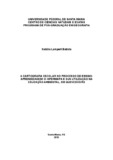| dc.creator | Batista, Natália Lampert | |
| dc.date.accessioned | 2016-05-19 | |
| dc.date.available | 2016-05-19 | |
| dc.date.issued | 2015-12-17 | |
| dc.identifier.citation | BATISTA, Natália Lampert. The school cartography in the process of teaching-learning: the hypermap and its use in environmental education in Quevedos/RS. 2015. 139 f. Dissertação (Mestrado em Geociências) - Universidade Federal de Santa Maria, Santa Maria, 2015. | por |
| dc.identifier.uri | http://repositorio.ufsm.br/handle/1/9455 | |
| dc.description.abstract | The Geography has as object of analysis the relationship between society and nature and, in this context, environmental issues is strongly marked in its speech. The maps reveal a complex and valuable language for understanding the geographic space. The School Cartography, in the approach of study place, can contribute significantly to the study of environmental issues, specifically the Environmental Education, which brings out the problem: what is the extent that students of Dom Pedro I Basic State School know and identify the environmental problems in your living space? In this sense, this study has the general objective to contribute to geographical studies of School Cartography emphasizing environmental problems Quevedos / RS. To the achievement of the research problem response and to better detail the general objective, the specific objectives are defined as: to know and characterize the reality of the Dom Pedro I Basic State School, focusing on environmental education; to understand the environmental awareness of high school students, as conscious mappers, through the construction of mental maps, stimulating and awakening the creativity; to develop a digital resource for teaching and learning linked to School Cartography (hypermap) that allows a dialogue between the local environmental reality and the theoretical conceptions of environmental education; and to evaluate the effectiveness of the proposed resource for the implementation of environmental education in place. The scientific method used was phenomenological and the approach was qualitative and descriptive. Based on the survey results, it is believed that the practices linked to local environmental understanding, as the construction of mental maps, the use of teaching materials aimed at the municipality (hypermap) and systematic reflection and written on their environmental reality, can contribute to the space understanding and temporary truths about the "world" in an articulated way, inter-relational and systemic, allowing a think more reflective and awakening the belonging feeling and the students identity. | eng |
| dc.description.sponsorship | Coordenação de Aperfeiçoamento de Pessoal de Nível Superior | |
| dc.format | application/pdf | por |
| dc.language | por | por |
| dc.publisher | Universidade Federal de Santa Maria | por |
| dc.rights | Acesso Aberto | por |
| dc.subject | Estudo do lugar | por |
| dc.subject | Espaço vivido | por |
| dc.subject | Pertencimento | por |
| dc.subject | Study place | eng |
| dc.subject | Living space | eng |
| dc.subject | Belonging | eng |
| dc.title | A cartografia escolar no processo de ensino-aprendizagem: o hipermapa e sua utilização na educação ambiental, em Quevedos/RS | por |
| dc.title.alternative | The school cartography in the process of teaching-learning: the hypermap and its use in environmental education in Quevedos/RS | eng |
| dc.type | Dissertação | por |
| dc.description.resumo | A Geografia possui como objeto de análise a relação sociedade-natureza e, neste contexto, a temática ambiental é fortemente marcada no seu discurso. Os mapas revelam, então, uma complexa e valiosa linguagem para a compreensão do espaço geográfico. A Cartografia Escolar, sob o enfoque do estudo do lugar, pode contribuir significativamente com o estudo das questões ambientais, mais especificamente com a Educação Ambiental, o que faz emergir o problema: em que medida os alunos da Escola Estadual de Educação Básica Dom Pedro I, conhecem e identificam os problemas ambientais existentes em seu espaço vivido? Nesse sentido, o presente estudo teve como objetivo geral contribuir para estudos geográficos de Cartografia Escolar enfatizando problemas ambientais de Quevedos/RS. Para a concretização da resposta ao problema de pesquisa e para um melhor detalhamento do objetivo geral, delineou-se como objetivos específicos: conhecer e caracterizar a realidade da Escola Estadual de Educação Básica Dom Pedro I, sob o enfoque da Educação Ambiental; compreender a percepção ambiental dos alunos do Ensino Médio, como mapeadores conscientes, por meio da construção de mapas mentais, estimulando e despertando a criatividade; desenvolver um recurso digital de ensino e aprendizagem vinculado a Cartografia Escolar (Hipermapa) que permita um diálogo entre a realidade ambiental local e as concepções teóricas de Educação Ambiental; e avaliar a eficiência do recurso proposto para a concretização da Educação Ambiental no lugar. O método científico utilizado foi o fenomenológico e a forma de abordagem foi qualitativa e descritiva. Com base nos resultados da pesquisa, acredita-se que as práticas vinculadas ao entendimento ambiental local, como a construção de mapas mentais, a utilização de materiais de ensino voltados ao município (Hipermapa) e a reflexão sistematizada e escrita sobre a sua realidade ambiental contribuem para o entendimento do espaço e das verdades temporárias sobre o mundo de modo articulado, inter-relacional e sistêmico, permitindo um pensar mais reflexivo e despertando o sentimento de pertencimento e de identidade dos educandos. | por |
| dc.contributor.advisor1 | Cassol, Roberto | |
| dc.contributor.advisor1Lattes | http://lattes.cnpq.br/0745996287597257 | por |
| dc.contributor.referee1 | Bezzi, Meri Lourdes | |
| dc.contributor.referee1Lattes | http://lattes.cnpq.br/2051877280467001 | por |
| dc.contributor.referee2 | Boer, Noemi | |
| dc.contributor.referee2Lattes | http://lattes.cnpq.br/7067957507021073 | por |
| dc.creator.Lattes | http://lattes.cnpq.br/9721608652971809 | por |
| dc.publisher.country | BR | por |
| dc.publisher.department | Geografia | por |
| dc.publisher.initials | UFSM | por |
| dc.publisher.program | Programa de Pós-Graduação em Geografia | por |
| dc.subject.cnpq | CNPQ::CIENCIAS HUMANAS::GEOGRAFIA | por |


